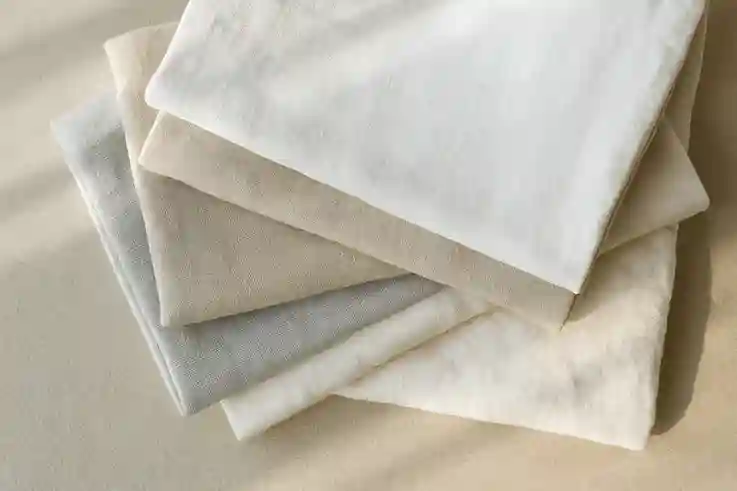The best fabrics for hot weather decide how cool and comfortable you feel every day. When temperatures climb, clothing choice matters more than style. Breathability, softness, and moisture control shape how your body handles heat. Wrong fabrics trap sweat, irritate skin, and leave you tired. Right fabrics keep you dry, light, and fresh even in direct sun.
Cotton remains a trusted favorite because its natural fibers let air flow freely. Linen offers crisp comfort with fast drying ability. Bamboo blends bring smooth texture and eco-friendly appeal. Rayon provides a lightweight, stylish alternative that drapes well. Chambray mimics denim but avoids the heavy weight. Each fabric has unique advantages, making it easier to match comfort with lifestyle.
Fabric choice also protects skin health. Breathable fibers prevent rashes, while smooth weaves reduce friction. Light textures help sweat evaporate, lowering the risk of overheating. You not only feel better but also stay more active during the hottest months.
Both natural and synthetic fabrics can work when chosen wisely. In this guide, you’ll discover which materials feel amazing, which blends balance comfort, and which fabrics you should avoid completely.
Why Fabric Choice Shapes Summer Comfort

Hot weather challenges the body, and fabric choice shapes how well you handle heat. Breathable fabrics allow sweat to evaporate quickly. This evaporation cools your skin and keeps your body temperature stable. In contrast, heavy or synthetic materials trap moisture and intensify discomfort.
Breathability always matters more than insulation in summer. Insulating fibers work in winter by holding warmth, but that same effect backfires under the sun. Airflow through the fabric helps heat escape naturally. Loose weaves and lightweight textures improve circulation, giving your body relief.
Fibers also interact differently with your skin. Natural fabrics like cotton or linen absorb moisture without sticking. Smooth fibers like bamboo reduce irritation and keep skin calm. On the other hand, tight synthetics cling and cause chafing during activity.
Cooling depends on simple principles. Light fabrics with open structures promote air exchange. Moisture-wicking fibers remove sweat from skin. Quick-drying materials prevent dampness that causes odor and heat buildup. Together, these properties explain why some clothes feel refreshing while others feel unbearable in summer.
Cotton: A Timeless Summer Essential
Cotton stands among the best fabrics for hot weather because of its natural airflow. The fiber allows skin to breathe, which makes daily wear more comfortable. This quality helps your body regulate temperature during long, hot days.
Cotton also absorbs sweat easily, keeping moisture away from the skin. However, it dries slowly compared to lighter fabrics. Damp cotton can feel heavy, especially in very humid conditions. Still, its softness and breathability make it reliable for most situations.
Casual daily wear benefits most from cotton. Shirts stay airy, dresses feel light, and bedding keeps nights cooler. The fabric remains versatile, practical, and gentle on the skin. For everyday comfort, cotton continues to be a trusted choice.
Linen: Light, Crisp, and Cooling

Linen remains one of the best fabrics for hot weather because of its loose weave. The structure enhances airflow and allows heat to escape quickly. This natural ventilation keeps your skin cool even under strong sun.
The fabric is highly absorbent yet dries much faster than cotton. Sweat does not linger long, which reduces discomfort. Linen stays light, crisp, and breathable, making it reliable for long summer days. Yes, linen wrinkles easily, but that texture adds charm. The creases signal freshness and natural comfort rather than formality. People often see wrinkles as part of linen’s relaxed style.
Linen works beautifully for vacation outfits and office wear. Loose shirts, flowing dresses, and tailored trousers all benefit from its cooling nature. Even bedding and curtains feel fresher when made from linen. It provides elegance while keeping heat under control.
Bamboo: Soft Comfort for Sensitive Skin
Bamboo has become one of the best fabrics for hot weather thanks to its natural breathability. The fibers feel smooth against the skin, which makes them ideal for sensitive users. Air moves easily through the fabric, helping your body release heat.
This material also wicks moisture away and resists odors. Sweat dries quickly, leaving the fabric fresh even after long wear. These properties make bamboo perfect for humid climates and active lifestyles. Another advantage is eco-friendly growth. Bamboo plants require little water and grow rapidly without harsh chemicals. Many people choose bamboo clothing for both comfort and sustainability.
Athleisure brands often use bamboo in leggings, t-shirts, and sports bras. Underwear and loungewear also benefit from its softness and odor resistance. With bamboo, you gain comfort, breathability, and peace of mind in one fabric.
Rayon: Affordable and Airy Alternative

Rayon offers one of the best fabrics for hot weather at an affordable price. It is semi-synthetic, yet feels naturally cooling. The smooth texture makes it pleasant to wear in summer heat.
The fabric drapes well, which gives clothing a stylish flow. Dresses, skirts, and blouses look elegant without feeling heavy. Many fashion brands use rayon because it combines comfort with modern design. Rayon absorbs sweat effectively, but it has one drawback. When wet, the fiber weakens and may lose durability. Careful washing and gentle handling extend the life of rayon clothing.
You will often see rayon in blouses, skirts, and dresses. It works well for office wear, vacation outfits, and casual evenings. With the right care, rayon delivers both comfort and style during hot months.
Chambray: The Cool Denim Look
Chambray gives you the denim style without the summer discomfort. The fabric is a lightweight cotton weave that allows air to flow. This breathability keeps your body cool while still offering a structured look.
It resembles denim in color and texture but feels softer and lighter. Unlike heavy jeans, chambray does not trap heat against your skin. The airy weave makes it a smarter option for hot weather outfits. Chambray works perfectly for casual shirts and shorts. Many summer wardrobes rely on it because it blends style and comfort. You can also find chambray dresses and skirts for versatile, breathable fashion.
This fabric lets you enjoy denim’s timeless appeal without overheating. With chambray, you keep the style while staying fresh under the summer sun.
Blends That Balance Comfort and Durability
Blended fabrics combine strengths from different fibers. They improve practicality while still working well in hot weather. The right mix keeps airflow intact and prevents discomfort.

Cotton-Polyester Blends Reduce Wrinkles
Cotton-polyester blends stay strong and easy to maintain. They resist shrinking and wrinkling, which keeps outfits looking neat all day. Less ironing is needed, so care becomes simpler. Small amounts of polyester add durability, but cotton preserves breathability. This balance makes the blend practical for both casual and work clothing.
Bamboo-Spandex Adds Stretch
Bamboo-spandex blends deliver comfort with built-in flexibility. The bamboo fibers keep clothes breathable and soft against the skin. Spandex adds stretch, which supports free movement during activity. This blend works well for fitted pieces that must still stay cool. You often see it in yoga pants, leggings, and performance t-shirts. The combination makes activewear both practical and refreshing in hot weather.
Linen Blends Soften Texture
Cotton-linen blends reduce wrinkles while softening linen’s naturally crisp feel. They keep the breathable quality of linen but feel smoother on the skin. This added comfort makes them easier to wear for long hours. The balance works well for office outfits, summer trousers, and lightweight jackets. With blends, you get linen’s cooling power and cotton’s softness in one fabric.
Choose Blends That Keep Airflow Intact
Always check fiber percentages on clothing labels before buying. Higher amounts of natural fibers like cotton, linen, or bamboo improve airflow and cooling. Small synthetic portions add strength, but too much traps heat and reduces comfort. The best blends balance durability with breathability, keeping you comfortable in hot weather.
Fabrics to Avoid in Hot Weather
Not every fabric works well in summer. Some materials trap heat, hold sweat, and make your body feel uncomfortable. Avoiding these choices helps you stay cool and fresh.
Polyester Traps Heat and Sweat
Nylon is lightweight and durable, but it struggles in hot weather. The fiber lacks natural breathability, which causes heat to build up quickly. When sweat collects, nylon tends to cling tightly to the skin. This sticky feeling often creates irritation, especially in humid conditions.
Activewear made with high nylon content can feel restrictive instead of refreshing. While nylon resists stretching and tearing, its poor airflow makes it less practical for summer clothing. For comfort in heat, it is better to choose fabrics that release moisture and allow ventilation.
Nylon Sticks to Skin
Nylon is lightweight and strong, but it performs poorly in summer heat. The fabric clings when damp, which creates a sticky, uncomfortable feel. In humid weather, this stickiness increases irritation and limits airflow. Sweat also tends to stay trapped instead of evaporating quickly. While nylon is useful for durability, it is best avoided in hot, humid conditions where comfort matters most.
Wool Feels Heavy and Itchy
Wool works well as an insulator during cold months, but it feels uncomfortable in hot weather. The fabric is dense and heavy, which traps heat instead of releasing it. This weight makes summer wear feel stifling rather than breathable.
Many types of wool also feel itchy against bare skin. In warm conditions, that irritation becomes more noticeable as sweat builds up. The combination of heat, weight, and texture reduces comfort, making wool a poor choice for hot climates. Some lightweight wools exist, but they still cannot match the cooling effect of cotton, linen, or bamboo. For summer, avoiding wool ensures better airflow and fresher skin.
Thick Synthetics Reduce Comfort
Thick synthetic fabrics block natural airflow, which prevents heat from escaping. Without ventilation, body temperature rises quickly, making summer wear uncomfortable. These fabrics also trap sweat and slow down evaporation. As a result, clothing feels heavy, damp, and restrictive.
Materials like acrylic blends or heavyweight polyester often fall into this category. They may look structured and durable but create discomfort in hot conditions. For summer dressing, avoiding thick synthetics ensures lighter, cooler, and more breathable outfits.
Fabric Comparison Chart
| Category | Fabric | Key Strength | Best Use |
|---|---|---|---|
| Best Fabrics | Cotton | Natural airflow | Casual wear, bedding |
| Linen | Loose weave cooling | Vacation outfits, office wear | |
| Bamboo | Soft and breathable | Athleisure, underwear | |
| Rayon | Light and airy | Blouses, skirts, dresses | |
| Chambray | Denim look, breathable | Casual shirts, shorts | |
| Blends | Cotton-Polyester | Durable, fewer wrinkles | Everyday wear, wrinkle-free look |
| Bamboo-Spandex | Stretch and flexibility | Activewear, fitted tees | |
| Cotton-Linen | Softens linen texture | Office wear, summer trousers | |
| Avoid | Polyester | Durable but traps heat | Avoid in hot weather |
| Nylon | Lightweight but sticky | Avoid in humid conditions | |
| Wool | Warm but heavy | Avoid in summer | |
| Thick Synthetics | Blocks airflow | Avoid in heat |
PMC NCBI: Effects of garment type (yarn/fabric) on microclimate temperature & humidity — A study comparing different fabrics (including high air permeability vs low) under physical activity in warm conditions. Provides data on how certain materials feel cooler.
Tips for Picking the Best Fabrics for Hot Weather
Making the right fabric choice becomes easier with a few simple guidelines. These tips help you stay cool, fresh, and stylish in summer.
Look for Light Colors and Loose Weaves
Light colors reflect heat away from the body, keeping you cooler under the sun. Dark shades absorb heat, which raises body temperature and makes clothing feel warmer. Loose weaves improve airflow by letting air move through the fabric. This circulation speeds up sweat evaporation and enhances cooling. Together, light shades and airy weaves reduce heat buildup and help clothing stay breathable in summer.
Prioritize Natural or Semi-Synthetic Fibers
Cotton, linen, bamboo, and rayon remain the most reliable fabrics for hot weather. These fibers absorb sweat and release heat, which keeps the body cooler. They also protect the skin by reducing irritation and allowing air to flow freely.
Semi-synthetics like rayon or bamboo blends add variety without trapping too much warmth. They combine comfort with style, offering lighter textures and smoother finishes. Choosing these fabrics ensures you stay comfortable in different settings, from casual wear to formal attire.
Consider Clothing Fit and Style
Tight clothing restricts airflow and traps sweat against your skin. This makes hot weather feel heavier and less comfortable. Loose fits allow skin to breathe by letting air circulate around the body. They also prevent friction and irritation caused by damp fabric clinging to the skin.
Flowing shirts, dresses, and trousers keep you cooler than clingy styles. These garments move with your body and improve ventilation. Choosing relaxed fits not only adds comfort but also creates a casual, fresh look for summer.
Transition from Casual to Formal Wear Smartly
Summer outfits should shift easily between casual and formal settings. Fabrics like linen create lightweight suits that work well in the office without trapping heat. Chambray offers a cooler option for casual days, giving the look of denim with added breathability.
Choosing versatile fabrics ensures comfort without losing style. A single wardrobe built on cotton, linen, and chambray pieces can cover both professional and relaxed occasions. This balance makes dressing for summer simple, practical, and comfortable.
“The best fabrics for hot weather are whispers of air, carrying comfort across skin and turning heat into harmony.”
FAQs: Best Fabrics for Hot Weather
Conclusion On Best Fabrics for Hot Weather
The best fabrics for hot weather make summer days cooler and more comfortable. Cotton, linen, bamboo, rayon, and chambray each offer unique cooling benefits. Blends add durability, but they work best when natural fibers dominate. Avoiding polyester, nylon, wool, and thick synthetics helps your body stay fresh and light. With smart fabric choices, you protect your skin, manage sweat, and enjoy comfort without losing style in the heat.
Now it’s your turn — which fabric keeps you the coolest in summer? Share your favorite picks and experiences in the comments below.
Your insights could help others choose the best fabrics for hot weather more confidently.

Silvia Heart is a lifestyle and wellness writer with a background in apparel and a degree in fashion. She blends creativity with practical insights, guiding readers toward intentional, balanced living. Through her approachable style and thoughtful storytelling, Silvia inspires her community to embrace both everyday joy and personal growth.


